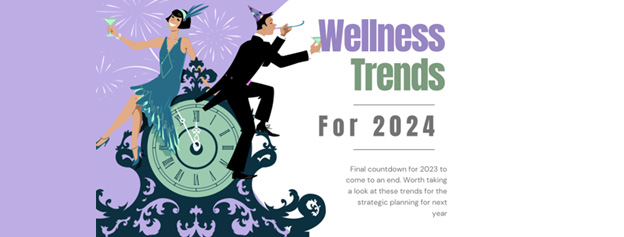Wellbeing Trends for 2024
November is typically a month when companies plan for the following year, therefore, it’s an ideal time to open the conversation about the well-being of individuals within the workplace environment.

Four years into the pandemic, there are still many things we don’t have clear, but in terms of work, things have taken a turn. We went from learning to work from home, creating spaces previously unimaginable to continue working, discovering virtual meetings that had previously been sporadic. Then came the upheaval of returning to the office, with people wanting to stay home, still out of fear of contagion, but also due to the irresistible scenario of not having to wake up so early, not having to spend so much time commuting, among other benefits. This paralleled what was globally known as “the great resignation,” where many people, with fear about the fragility of life and how Covid showed us how easy it can be to die, chose to resign from their stressful positions, with intense workloads, and well, in many cases encouraged by the economic benefits from some governments. The conversation about employee well-being gained impressive momentum, and companies began to devise a slew of strategies on this issue, from conferences to health weeks with more toys, fruit at office receptions, and even passes for spas and gyms. But that has been changing, and what has happened is not that those well-being-focused benefits don’t work, but that the problem is much deeper; people are exhausted with the pace of work and life, the demands within the work environment are increasing, and they add to the demands of family and social life. So we run the risk that leaders and managers no longer see the well-being of their employees as a priority. And more than ever it is a priority, as doing nothing represents a very high risk that is already beginning to be seen: high levels of presenteeism (being there without being there, very low performance and productivity), “quiet quitting” (or silent resignation, which refers to showing up to work and doing the bare minimum, without a sense of belonging or love for their work), burnout, the mental and emotional health of people, and all of this translates into low performance, productivity, and lack of purpose.
So, what to do in 2024 from the perspective of people’s well-being in companies?
Wellness trends for 2024 aim to work on this acronym, REMAINS:
Belonging, where employees truly feel part of a community with a purpose greater than themselves, a tribe.
Energy, sustainable actions so that people can have access to optimal energy levels and recover. Rest is key!
Risk, reducing the risk of physical, mental, and emotional health for employees.
Stress management, improving teams’ and individuals’ ability to adapt to crisis situations, for better emotional and stress management.
Self-care, beyond actions for physical care, working on boundary management, time management, and managing situations that are detrimental to people’s emotional health.
Individual needs, understanding that a culture focused on the well-being of its employees must be a collective effort to meet the individual needs of each one.
Expectations, designing expectations management both from the employer to the employee, and from the employee to the employer. Generating balance and benefits for both parties.
Trust, within a work environment where people feel they can raise their hand and speak. Creating spaces for dialogue, training leaders to evoke that trust, where the employee is certain they can speak up and will be listened to with empathy.
Choice, flexibility is a very trendy word for 2024. Considering and leaving behind the fear of flexibility in schedules, workdays, hybrid work, etc.
Blogs
World Sleep Day
World Sleep Day: To Save Everything from Marriages to High-Performance TeamsAnother day we give a name to, to remind ourselves of something that should be remembered every day: the importance of sleep and rest in our routines. There's much to discuss about sleep, but...
What pace are you keeping up with: the company’s pace, or your family’s pace?
What pace are you keeping up with: the company's pace, or your family's pace? I attended a leadership conference where the topic of the leader´s pace was discussed. In an increasingly fast-paced world, we've bought into the idea that the faster we run, the more...
Self-care, far from being a selfish act…
Self-care, far from being a selfish act...We have been talking about exhaustion, stress, the importance of sleep, and previously about nutrition and movement... all pillars of well-being.We have concluded that without habits that directly impact these pillars, it is...
Mastering the Art of Taking a Nap!
Mastering the Art of Taking a Nap!Have you ever felt that absurd tiredness, where your eyes start to close around 2:30 in the afternoon (or maybe at 4:00 PM if you're in Mexico)?Do you feel exhausted and stressed because you have a lot of work to do? After lunch, it's...
Health + Mental Well-being = Flourishing!
Health + Mental Well-being = Flourishing!Health, is it the absence of illness? Mental health, could it be the absence of mental illnesses?The correct answer should be no! The World Health Organization defines health as follows: "a state of complete physical, mental,...
States of – “FLOW”
States of - "FLOW"Have you ever felt in a state of maximum productivity? A moment where everything flows, your ideas, your ability to concentrate, time flies by, and yet minutes pass and you don't even realize it.That's called the state of flow or FLOW, moments where...






